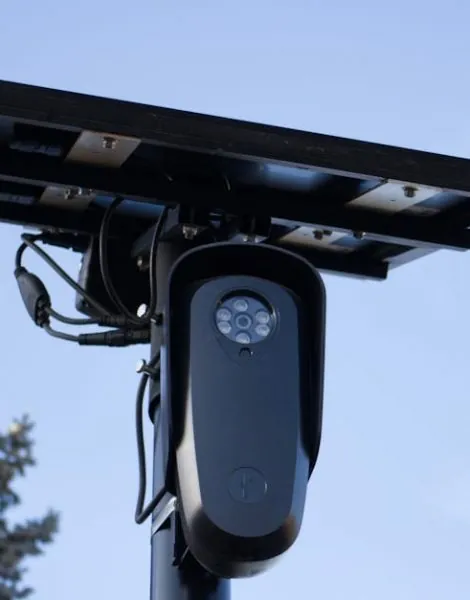In a world where even your pet goldfish seems to have a social media presence, it’s time to step up your home security game. Wireless security cameras are the unsung heroes of modern safety, keeping an eye on your castle while you binge-watch your favorite shows. No more worrying about whether that rustle in the bushes is a raccoon or an intruder. With these nifty gadgets, you’ll know exactly who’s lurking around your property—spoiler alert: it’s probably just the neighbor’s cat.
Gone are the days of tangled wires and complicated setups. Wireless security cameras offer simplicity and flexibility, letting you monitor your home from anywhere. Whether you’re at work, on vacation, or just chilling on the couch, you’ll have peace of mind knowing your home is under watchful eyes. So why not embrace the future of security and keep your home safe, all while adding a touch of tech-savvy flair to your life?
Table of Contents
ToggleOverview of Wireless Security Cameras
Wireless security cameras serve as essential components of modern home security systems. They offer flexibility in monitoring properties without the restrictions of wires.
Key Features
Wireless security cameras often come equipped with high-definition video resolution, ensuring clear images. Many models feature motion detection, triggering alerts when activity occurs within the camera’s range. Night vision capabilities enhance security during low-light conditions, enabling effective monitoring after dark. Remote access through mobile apps allows homeowners to view live footage from anywhere, promoting ease of use. Cloud storage options provide secure backups of footage, safeguarding against local data loss.
Benefits of Wireless Systems
Wireless systems simplify installation, allowing for quick setup without the need for professional help. Flexibility in camera placement enhances coverage, letting users position cameras in optimal locations for surveillance. These systems typically require fewer maintenance efforts since there are no wires to replace or repair. Cost savings arise from the absence of wiring expenses and installation fees. Wireless security cameras can integrate with smart home systems, expanding security options and enhancing user experience.
Types of Wireless Security Cameras
Wireless security cameras come in various types, each designed for specific monitoring needs. Understanding these categories helps in selecting the right camera for optimal surveillance.
Indoor Cameras
Indoor cameras focus on maintaining security within a home or business. They often feature compact designs suitable for placement on shelves or in corners. High-definition video quality ensures clear images during the day and night thanks to night vision capabilities. Motion detection alerts notify users of any unusual activity, enhancing home security. Remote access via mobile apps enables users to monitor live feeds from anywhere. Some models come with cloud storage options for easy access to recorded footage.
Outdoor Cameras
Outdoor cameras protect external areas around a property. They are built to withstand unfavorable weather conditions, often featuring weatherproof housings. These cameras typically offer a wider field of view, ensuring better coverage of larger spaces. High-definition video quality assists in capturing detailed images of any movement. Advanced options include motion detection and two-way audio for real-time communication. Users can also access live feeds and recorded footage through mobile applications. Enhanced features, such as night vision, improve visibility during low-light conditions.
Installation and Setup
Installing wireless security cameras involves several straightforward steps that ensure optimal performance and security coverage.
Selecting the Right Location
Identifying an ideal installation site enhances camera effectiveness. Evaluate areas that require monitoring, such as entry points, driveways, and backyards. Opt for locations with minimal obstructions, allowing for a clear view of the intended area. Consider mounting cameras between eight to ten feet high for optimal field of view and protection from tampering. Indoor cameras focus on high-traffic areas, while outdoor cameras should withstand exposure to harsh weather conditions. Verify that locations are within the range of the Wi-Fi signal for uninterrupted connectivity.
Connecting to Wi-Fi
Establishing a secure Wi-Fi connection is essential for wireless security cameras. Locate the camera within 30 feet of the Wi-Fi router during setup to ensure a strong signal. Use the manufacturer’s mobile app for a simplified connection process, which usually involves scanning a QR code or entering the Wi-Fi credentials. Enabling a secure password on the home network adds an extra layer of protection against unauthorized access. Once set, review the app to ensure a stable connection between the camera and the router. Adjust camera settings as needed to optimize performance based on individual security needs.
Performance and Image Quality
Performance and image quality represent crucial aspects of wireless security cameras. High-quality video feed enhances monitoring effectiveness and overall security.
Video Resolution
Resolution significantly impacts the clarity of recorded images. Many wireless security cameras offer high-definition (HD) video, typically ranging from 720p to 4K. A 1080p resolution balances quality and storage efficiency, providing clear images without excessive data usage. In situations requiring detailed observation, 4K cameras deliver exceptional clarity, enabling users to discern faces or license plates. Selecting the appropriate resolution depends on individual needs, such as home-size and monitoring scope.
Night Vision Capabilities
Night vision capabilities ensure effective surveillance in low-light conditions. Most modern wireless security cameras utilize infrared (IR) technology for clear night footage. Typically, these cameras can capture black-and-white images in total darkness, with ranges from 20 to 100 feet. Some models incorporate color night vision, enhancing visibility by utilizing low-light color sensors. Selecting cameras with robust night vision features helps maintain security and monitoring efficiency during nighttime hours.
Integration with Smart Home Systems
Integrating wireless security cameras with smart home systems enhances overall security and convenience. Seamless connections expand monitoring options and simplify user experiences.
Compatibility with Devices
Wireless security cameras typically support various smart home devices. Many models function independently, yet most offer compatibility with Alexa, Google Assistant, and similar platforms. Users can control multiple devices through a single app, simplifying management. For instance, camera feeds may display on smart displays or mobile phones, enabling quick assessments. Some cameras integrate with smart doorbells and alarms, creating a comprehensive security network. By connecting these devices, he or she can create a synchronized response to potential threats.
Remote Access and Control
Wireless security cameras facilitate remote access from anywhere. Users often rely on mobile applications to view live feeds and receive notifications. Specific features allow for real-time interaction, such as two-way audio communication. Responding to alerts or viewing recorded footage becomes convenient and straightforward. Many cameras offer cloud storage, granting access to archived videos regardless of location. This ability to monitor and manage security enhances peace of mind, particularly while away from home.
Wireless security cameras represent a significant advancement in home safety and surveillance. Their ease of installation and flexibility make them a top choice for homeowners looking to enhance security without the hassle of traditional wired systems. With features like high-definition video, motion detection, and remote access, these cameras not only provide peace of mind but also integrate seamlessly into smart home ecosystems.
As technology continues to evolve, the capabilities of wireless security cameras will only improve, offering even more robust solutions for protecting homes and properties. Investing in these devices is a proactive step toward ensuring safety and security in today’s fast-paced world.









